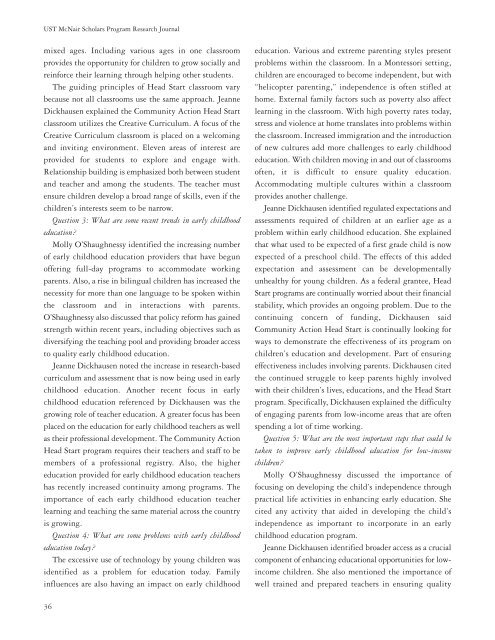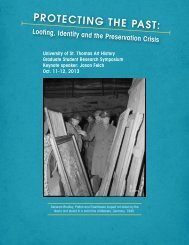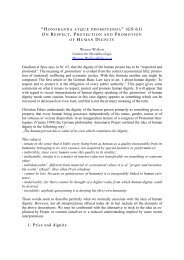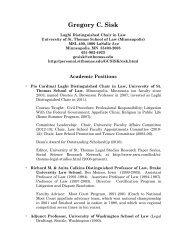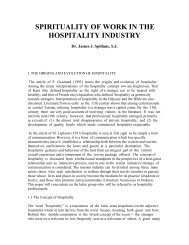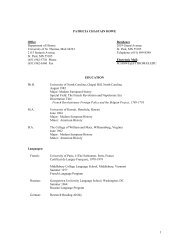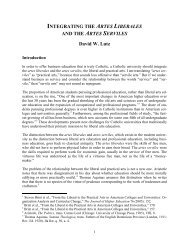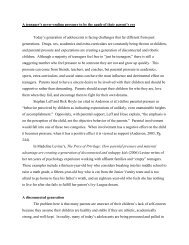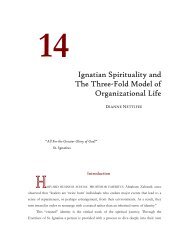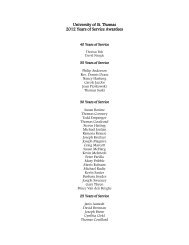dr. ronald e. mcnair acknowledgements - University of St. Thomas
dr. ronald e. mcnair acknowledgements - University of St. Thomas
dr. ronald e. mcnair acknowledgements - University of St. Thomas
You also want an ePaper? Increase the reach of your titles
YUMPU automatically turns print PDFs into web optimized ePapers that Google loves.
UST McNair Scholars Program Research Journal<br />
mixed ages. Including various ages in one classroom<br />
provides the opportunity for chil<strong>dr</strong>en to grow socially and<br />
reinforce their learning through helping other students.<br />
The guiding principles <strong>of</strong> Head <strong>St</strong>art classroom vary<br />
because not all classrooms use the same approach. Jeanne<br />
Dickhausen explained the Community Action Head <strong>St</strong>art<br />
classroom utilizes the Creative Curriculum. A focus <strong>of</strong> the<br />
Creative Curriculum classroom is placed on a welcoming<br />
and inviting environment. Eleven areas <strong>of</strong> interest are<br />
provided for students to explore and engage with.<br />
Relationship building is emphasized both between student<br />
and teacher and among the students. The teacher must<br />
ensure chil<strong>dr</strong>en develop a broad range <strong>of</strong> skills, even if the<br />
chil<strong>dr</strong>en’s interests seem to be narrow.<br />
Question 3: What are some recent trends in early childhood<br />
education?<br />
Molly O’Shaughnessy identified the increasing number<br />
<strong>of</strong> early childhood education providers that have begun<br />
<strong>of</strong>fering full-day programs to accommodate working<br />
parents. Also, a rise in bilingual chil<strong>dr</strong>en has increased the<br />
necessity for more than one language to be spoken within<br />
the classroom and in interactions with parents.<br />
O’Shaughnessy also discussed that policy reform has gained<br />
strength within recent years, including objectives such as<br />
diversifying the teaching pool and providing broader access<br />
to quality early childhood education.<br />
Jeanne Dickhausen noted the increase in research-based<br />
curriculum and assessment that is now being used in early<br />
childhood education. Another recent focus in early<br />
childhood education referenced by Dickhausen was the<br />
growing role <strong>of</strong> teacher education. A greater focus has been<br />
placed on the education for early childhood teachers as well<br />
as their pr<strong>of</strong>essional development. The Community Action<br />
Head <strong>St</strong>art program requires their teachers and staff to be<br />
members <strong>of</strong> a pr<strong>of</strong>essional registry. Also, the higher<br />
education provided for early childhood education teachers<br />
has recently increased continuity among programs. The<br />
importance <strong>of</strong> each early childhood education teacher<br />
learning and teaching the same material across the country<br />
is growing.<br />
Question 4: What are some problems with early childhood<br />
education today?<br />
The excessive use <strong>of</strong> technology by young chil<strong>dr</strong>en was<br />
identified as a problem for education today. Family<br />
influences are also having an impact on early childhood<br />
36<br />
education. Various and extreme parenting styles present<br />
problems within the classroom. In a Montessori setting,<br />
chil<strong>dr</strong>en are encouraged to become independent, but with<br />
“helicopter parenting,” independence is <strong>of</strong>ten stifled at<br />
home. External family factors such as poverty also affect<br />
learning in the classroom. With high poverty rates today,<br />
stress and violence at home translates into problems within<br />
the classroom. Increased immigration and the introduction<br />
<strong>of</strong> new cultures add more challenges to early childhood<br />
education. With chil<strong>dr</strong>en moving in and out <strong>of</strong> classrooms<br />
<strong>of</strong>ten, it is difficult to ensure quality education.<br />
Accommodating multiple cultures within a classroom<br />
provides another challenge.<br />
Jeanne Dickhausen identified regulated expectations and<br />
assessments required <strong>of</strong> chil<strong>dr</strong>en at an earlier age as a<br />
problem within early childhood education. She explained<br />
that what used to be expected <strong>of</strong> a first grade child is now<br />
expected <strong>of</strong> a preschool child. The effects <strong>of</strong> this added<br />
expectation and assessment can be developmentally<br />
unhealthy for young chil<strong>dr</strong>en. As a federal grantee, Head<br />
<strong>St</strong>art programs are continually worried about their financial<br />
stability, which provides an ongoing problem. Due to the<br />
continuing concern <strong>of</strong> funding, Dickhausen said<br />
Community Action Head <strong>St</strong>art is continually looking for<br />
ways to demonstrate the effectiveness <strong>of</strong> its program on<br />
chil<strong>dr</strong>en’s education and development. Part <strong>of</strong> ensuring<br />
effectiveness includes involving parents. Dickhausen cited<br />
the continued struggle to keep parents highly involved<br />
with their chil<strong>dr</strong>en’s lives, educations, and the Head <strong>St</strong>art<br />
program. Specifically, Dickhausen explained the difficulty<br />
<strong>of</strong> engaging parents from low-income areas that are <strong>of</strong>ten<br />
spending a lot <strong>of</strong> time working.<br />
Question 5: What are the most important steps that could be<br />
taken to improve early childhood education for low-income<br />
chil<strong>dr</strong>en?<br />
Molly O’Shaughnessy discussed the importance <strong>of</strong><br />
focusing on developing the child’s independence through<br />
practical life activities in enhancing early education. She<br />
cited any activity that aided in developing the child’s<br />
independence as important to incorporate in an early<br />
childhood education program.<br />
Jeanne Dickhausen identified broader access as a crucial<br />
component <strong>of</strong> enhancing educational opportunities for lowincome<br />
chil<strong>dr</strong>en. She also mentioned the importance <strong>of</strong><br />
well trained and prepared teachers in ensuring quality


